A few months ago, Hipsters of the Coast ran a piece discussing whether or not I was overpaid for my work on StarCityGames.com.
Was Gerry Thompson Overpaid by Star City Games? https://t.co/rhoD1mmh09
— Hipsters of the Coast (@HipstersMTG) April 4, 2022
Rich Stein recently reached out and offered to pay me $1,000 for an article they could run during their tenth anniversary as a callback to that piece and I was happy to oblige. So, here I am! On top of the exorbitant price tag, Rich allowed me to choose my own topic and I wanted to get him his money’s worth.
Part of the reason I was well-compensated at SCG was because I’m good at my job. Maybe I’m not as adept at putting words together as some of my colleagues, but I am capable of crafting a compelling narrative and am typically aware of the types of things my readers would click on.
First and foremost, I try to provide value, both for the company who happens to be paying me and for the audience consuming the content. The question was, “How do I provide the most value for Hipsters of the Coast (and by extension, their readers)?”
It was clear that a typical decklist and sideboarding guide wasn’t going to be sufficient, so I dug deep and came up with a few topics that would make for great content and be worthy of my $1,000 price tag. Among them was a secret I’ve kept for almost five years, which seemed far more compelling than anything else I could write about.
So, here we go:
I did a significant chunk of the development work on the first Modern Horizons.
That’s right, if you’ve ever wondered who to blame for Hogaak, Arisen Necropolis, Wrenn and Six, or Urza, Lord High Artificer, it’s probably me.
(Actually, that’s a bit of a lie, which I’ll get into. However, if you’re looking for a scapegoat and don’t particularly care about facts, go off.)
Now, that revelation probably leads you to a host of questions, which hopefully I’ll be able to answer. I’m sure the first is, “Why didn’t we know about this?” That answer is a little complicated. Let’s start at the beginning.
Before my contract for MH1 (known internally as Contemporary or CTY) was signed and even throughout most development, the question of whether or not I was going to be credited was ongoing. I didn’t particularly care either way and wanted to do what was best for everyone involved. Although I’ve been critical of Wizards of the Coast in recent years, I’d like to think I have many friends that work there. At the time, I cared about not having things blow back on them in any way and I still do.
There was still the lingering fear of optics should it come out that an active Pro Tour player was helping develop sets, therefore getting to play with the cards before anyone else. That could create a potential advantage over other competitors in the field and paint Wizards in a poor light. Having worked there a few years earlier, I knew those concerns well and respected them.
In case anyone needed any assurances that it actually doesn’t give you a significant edge:
There was a Modern Pro Tour where Hogaak was legal.
I played Jund.
I did not make Day 2.
Hope that clears everything up!
Seriously though, that concern is largely overstated. We spend so much time playing with cards and decks that end up getting changed or outright killed that it’s often to our detriment because we have preconceived notions based on those experiences. I can point to specific instances of that happening too.
In the interest of fairness, the counter argument is the fact that my contract was from January-April in 2018 and I got second at a Modern Pro Tour on February 4th, 2018. Maybe those extra couple weeks I spent playing Modern, even if the games were fake, did help. Then again, it also took time away from testing the actual format. For what it’s worth, it was also one of the happiest times of my life, and the status of my mental health has historically determined how well I performed on any given day. Mysteries.
In the end, we all decided it would be better if my contract wasn’t disclosed publicly, although WotC couldn’t legally leave me off the credits unless I wanted to be. Ultimately, it was my decision, so I chose to protect them rather than add another game design notch to my resume. As is the case with most things, it wasn’t an entirely selfless decision. At the time, I figured if I were going to work in game design, it would probably be with Wizards anyway. They seemed to value me (at least back then), so the door seemed open.
It might seem odd that I had a random Wizards of the Coast contract in 2018, but in reality, there were several different people in the building that were interested in working with me. It was just a matter of trying to find something that worked for everyone. In this case, we found something, but it involved me keeping it a secret.
To add more context, we can rewind to Pro Tour Amonkhet in May of 2017. In the week leading up to the PT, I was in talks with someone at WotC about coming back to work full-time, albeit this time for a non-MTG related project that ended up being the newly (and finally!) released Magic Spellslingers. We didn’t quite know what that arrangement would look like, which is why it was taking some time to finalize things.
Could I still play professional Magic? Would I still be able to create content? Would that change if I worked on any Magic sets?
At the time, I was hoping to stay away from working on Magic sets because that would increase the likelihood that I could keep doing what I was doing. My WotC person agreed, but was waiting on actual confirmation.
After I won that Pro Tour, I had to have an awkward phone call.
WotC person: “So, uh, about that contract… I’m guessing it’s not gonna happen anymore.”
Me: “Yeah…”
Given that I was newly Platinum and qualified for Worlds, it didn’t look like I’d be phasing out of tournament Magic anytime soon, so taking a full-time position didn’t make much sense.
Thankfully, another opportunity fell into my lap, which allowed me to work on Modern Horizons without giving up any of the tournaments or content creation, which were my main priorities at the time. It was a cool, fun, unique, and important project that I was proud to be a part of. Plus, I was confident in my ability to actually contribute meaningfully given my skill set, so I was excited for it.
Why talk about this now? Well, as I mentioned, technically I can. I could have at any point, but decided out of respect that I wouldn’t, even if I thought it was unlikely to cause any issues. It’s so far removed at this point that it won’t cause a scandal, plus competitive Magic is basically on its last gasp anyway. Modern Horizons 2 had active pro players like Brad Nelson, Brian Braun-Duin, and Sam Black work on the set, openly talk about it, and there wasn’t much blowback from it, if any.
My involvement was more hands-off than when I previously worked in-house, although part of that was a product of me being a poor designer and everyone, especially me, being aware of that. If you ask me to come up with a new Magic card, I won’t be able to give you a good one. If you give me multiple choice, I’ll ace it. If you tell me you want to keep the card functionally the same, I’ll be able to tune it for a constructed format. It’s just how my brain works. I have a narrow set of development skills and that’s about it.
This experience consisted of me suggesting what Modern archetypes would be fun to give new tools, building decks, playing games, and giving feedback based on those games. Any changes that got made based on that feedback were mostly out of my hands. I learned from my experience working there in 2013-2014, adjusted my expectations, and the whole thing was smoother as a result. Overall, it was a great experience.
Let’s start with the big guy.
Hogaak, Arisen Necropolis
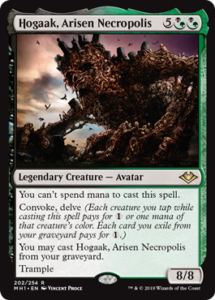
To understand how Hogaak, Arisen Necropolis came to be, you have to understand what the process was like. Since I was still playing Pro Tours, I wasn’t actually allowed to see any of the upcoming Standard-legal sets, which meant I couldn’t go on the third floor, where R&D was located. Instead, I was secluded to a tiny meeting room on the first floor. You need a badge to get inside the WotC building, but the first floor still has a ton of foot traffic, so we had to be careful not to leave any cards or printouts lying around that could potentially leak into the public. If you were one of the fortunate few to have played in a MOCS or SSS finals, you know the room we were in.
Each day, Tom Ross, Dan Musser, and Michael Majors had to carry down massive boxes of Modern decks, cards to proxy on, and materials we’d need to play games, such as bowls of dice. Sometimes they included laptops to go over card files or look at visual representations of decklists, playtesting results, or emails with directives from Adam Prosak, Dan Burdick, or Aaron Forsythe.
I felt bad for them. I’d only show up for four hours a few times a week and they’d have to carry all that stuff back upstairs again. At the time, it probably felt like a fine idea, but toward the end, it didn’t seem like it was worth the effort just to get my input. Maybe they feel differently.
Standard sets featured cards that made their way into Modern at a much higher clip than they used to, so they made a list of cards that might potentially see play in Modern. That seemed like a fine compromise considering I wasn’t allowed to see the Standard sets in their entirety, at least as long as the list was accurate.
Maybe you can see where this is going…
Core Set 2019 was released on July 13th, 2018, three months after Modern Horizons development ended for me. They knew Stitcher’s Supplier was a card in Core Set 2019 and didn’t tell me. To put it into perspective, Ravnica Allegiance was released on January 25th, 2019 and the list I was shown included Mission Briefing (lol).
At some point, Tom Ross recited the text of Creeping Chill to me, another card not on the list, and asked if it would see play in Dredge. I couldn’t say for sure at the time, but the second you try it, you see how much the deck benefits. Tom, to his credit, was doing his best to ensure we didn’t overlook anything.
Anyway, I put Hogaak in some decks, but really struggled with having strong enough enablers, especially ones that cost one mana or less. Seeing as how I pegged Stitcher’s Supplier as one of the best cards in Core Set 2019 and have a penchant for graveyard decks, you better believe I would have put that card into many, many decks while testing MH1. I assure you that if Stitcher’s Supplier were on that list, we would have lived in a different world.
This was the original version of Hogaak, at least as it was officially input into their internal database:
Waste Colossus
5BG
Convoke, Delve, Trample
You can’t spend mana to cast CARDNAME
10/10
If you asked me, I would swear that the initial versions could only be cast from the graveyard. Apparently, that doesn’t seem to be the case, but I remember struggling to find suitable discard outlets to allow me to cast Hogaak. It’s possible it went from idea to playtest before it actually went into the database, but I can’t say for sure.
Regardless, I built decks that looked remarkably similar to the Hogaak decks that started showing up, except they didn’t include Stitcher’s Supplier. As it turns out, they are far more manageable if Stitcher’s Supplier didn’t exist! If the Hogaak decks don’t appear to be particularly strong in our testing, then people eventually stop paying attention to them.
Of course, we also missed one of the big pieces.
Altar of Dementia
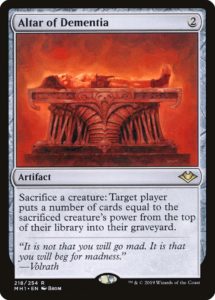
“Should we include Altar of Dementia in MH1? Is it potentially busted?”
“We did a couple passes [of things that exist already] and couldn’t find anything. I assume it’s fine.”
Oops.
Looking back at my old emails, I had Altar of Dementia on the “maybe include” portion of some Hogaak decks, but never got them into play. Altar and Hogaak basically going infinite with Bridge from Below wasn’t immediately obvious to me, so I don’t know if I would have figured that out on my own, although someone else could have pointed it out potentially.
We missed it and weren’t focused on those decks as much because they didn’t seem particularly strong. Something small can easily lead to a misconception of a card’s power level. That alone can have the power to invalidate all the good work we did on a set and how a set is remembered by the general public. When your team is roughly four people, you don’t have the bandwidth to check and double-check everything, especially with a format as large as Modern.
At some point, the topic of how to measure success with a project like this came up. I believe it was Majors who suggested, “If we only have to ban two cards, I’ll call it a success.”
Given the scope of the project compared to the size of our team, we all agreed.
Wrenn and Six
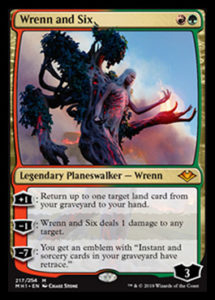
What the hell happened here?
Well, that’s a good question and one that I also share. When my contract ended, the set wasn’t fully complete and one of those cards without finalized text was Wrenn and Six. We couldn’t find text we were happy with yet, and the first time I saw the card was during preview season with everyone else. I’d like to say I would have done things differently than they did, but that’s easy to say in hindsight.
One of the main things we were working on throughout the process was trying to find a Gruul “lands matter” deck. Ideally, that would look something like a Gruul aggro deck that had some land synergy and staying power, but that proved more difficult than we first thought.
Some of the incentives were engines like Life from the Loam and Seismic Assault, which made any one-shot piece of card advantage pretty useless by comparison. If you wanted to go hard on filling your graveyard for something like Terravore, you’d be better off playing Dredge instead.
Over time, some of the payoffs for the archetype at higher rarities were removed from the set because they weren’t serving their intended goals for constructed. “Lands matter” remained a limited theme, but soon we stopped trying in constructed. Wrenn and Six was already concepted and filled a G/R planeswalker spot in the set, so it needed text.
In the end, it ended up being one of those cards that is technically a “lands matter” card, but is so strong on rate that you don’t need to pair it with the mediocre lands matter cards. Everyone plays it because it’s the Tarmogoyf of planeswalkers—it does it all.
Big oops.
Urza, Lord High Artificer
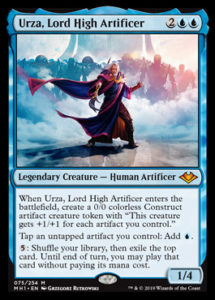
“You see, he summons a Karn-struct and is Temporal Aperture and Tolarian Academy. Isn’t that super cool?”
“I mean, I guess, but isn’t the mana ability way, way better than Tolarian Academy? Also, it doesn’t even really evoke thoughts of Tolarian Academy because of how different it is and—”
*shhhhh*
Obviously Urza and Yawgmoth are sort of mirror images of each other in this set. Ideally, they see some play, but it’s not important that they make it into a Tier 1 deck. We wanted to create a fun sandbox for people to explore and hopefully that process is rewarding.
One of the last emails I got was from Tom Ross and he mentioned that both Wrenn and Six and Urza weren’t things he was currently looking to put into decks. He was right, of course. At the time, Urza had “T: Add U for each artifact you control,” but likely due to Tom’s email, that ability received a significant buff.
Wrenn should, at the very least, have one less starting loyalty. Not dying to Lightning Bolt and being overly hostile to small creatures are a wild combination of issues for a two mana planeswalker. It got banned in Legacy and gets splashed as a fourth color in multiple Modern decks. Yeesh.
As for Urza, he entered Modern at an odd time. Mox Opal was scary throughout Modern’s lifespan and cards like Oko, Thief of Crowns and Uro, Titan of Nature’s Wrath followed shortly after. There’s also the Thopter Foundry / Sword of the Meek combo that’s enabled by his new mana ability. Regardless of what happens, Urza will probably not be remembered fondly. Yet I don’t think it’s his fault.
While I’d happily nerf Wrenn, I’m not sure that I would touch Urza. Getting a four mana card into Modern isn’t easy, plus Urza functions in a fair way unless you break apart his synergy. Artifact synergies are easily hated on, which can cause churn and keep Modern interesting as long as Urza isn’t surrounded by Oko and the like.
Seasoned Pyromancer & Ranger-Captain of Eos
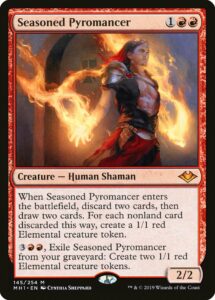
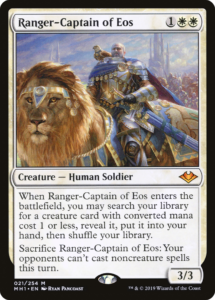
These are almost straight from Michael Major’s brain directly to print. Of course they needed a little massaging, but his initial designs were on point for what sort of card would make it into Modern in a positive way. I’m not easily impressed and I certainly don’t get envious very often, but damn do I want some of the genius that Majors possesses.
He wanted to fill out the cycle of higher rarity utility creatures like Tarmogoyf, Dark Confidant, and Snapcaster Mage. Even though they don’t exactly fill a cycle, there were suddenly reasons to look at non-green colors when building a midrange deck. Absolute win.
Force of Rage
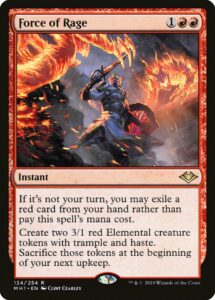
Honestly, I’m not sure if I can even explain this one.
The Forces were supposed to be a cycle, mainly because they wanted Force of Negation and doing that without a cycle felt weird. Ideally, they would be cards that would be used defensively, which is a good way to ensure that adding more free spells to the format doesn’t lead to degenerate combo decks. Force of Negation would technically protect your combo if it was happening on your opponent’s turn, but that meant something like Through the Breach, which is slow and not particularly consistent, so it didn’t seem threatening.
Force of Vigor was well-liked and Force of Despair was acceptable, although it meant that the red Force couldn’t be a Pyroclasm or something similar because they’d feel the same. Making a pair of 3/1 blockers is similar enough anyway, even if it doesn’t feel that way. Being able to use it offensively made it less egregious, but also more confusing as to why the card existed.
After Force of Virtue broke the “must be defensive” rule, Force of Rage should have been revisited.
Arcum’s Astrolabe
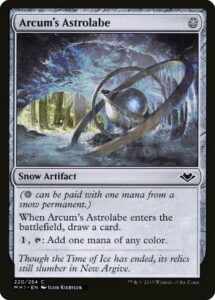
The snow support was initially supposed to help a Tier 2 ramp control deck that used Arcum’s Astrolabe to make up for the fact that you were playing all basics. Prismatic Vista helped too! Ice-Fang Coatl and Dead of Winter could control the board and you’d use Marit Lage’s Slumber as a combo with Scrying Sheets. One of the big payoffs was a snow version of Cabal Coffers. Another was a Simic Sky Swallower with affinity for snow permanents. Those cards got the axe and I truly do not remember why.
Despite building multiple decks with Goblin Welder (before it became Goblin Engineer), I never put Arcum’s Astrolabe into a deck with it. It could have been that the timeline for when Astrolabe was created fell between the time when Goblin Welder was being considered for the set and eventually cut and before Goblin Engineer was concepted.
Regardless, I was tunnel visioned on Astrolabe being a snow-related card and didn’t explore whether it would be worth it for other archetypes. There were also plenty of other people in the room who did the same thing. Overall, we massively failed on this one for no particular reason.
Crashing Footfalls
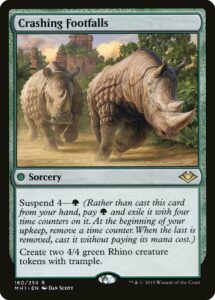
Adam Prosak wanted to give green a cascade spell. He felt bad that green was left out after Hypergenesis was banned, so he rectified it. It didn’t seem like it would hit or make anyone particularly happy, but they knew they were going to unban Bloodbraid Elf and Jace, the Mind Sculptor at some point and decided to let people live the dream.
With the Shardless Agent printing in Modern Horizons 2, Crashing Footfalls became the focal point of an entire deck, which is totally awesome.
Kaya’s Guile
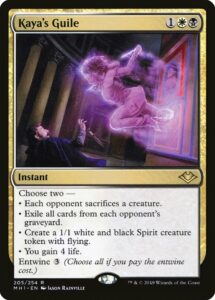
This card is the result of a lot of love. Commands and Charms are cards that certainly have love and care put into them, but rarely as much as you’d expect considering how beloved they end up being, such as Kolaghan’s Command.
In this case, we knew Kaya’s Guile (originally Sorin’s Command) couldn’t be a disappointment. Every card in the set had to matter to someone, and in a Modern-focused set, having a singleton multi-colored Command meant that there would be more expectation on it for it to perform. If there’s a full cycle, the pressure rests on the cycle as a whole rather than the individual, but we didn’t have that to fall back on.
Many abilities were considered, the numbers were massaged, and the potential use cases were discussed in-depth. In the end, I think we all thought it might fall a little short, but couldn’t necessarily adjust the numbers without making it ubiquitous. Thankfully, players did seem to love it and it saw more play than I expected. Sometimes that was due to a metagame being full of Dredge and Burn, but that was okay!
Plague Engineer
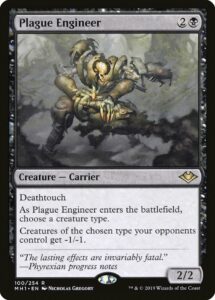
Y’all hate this card.
At its core, Modern Horizons is a pile of in-jokes. If you don’t get the joke, hopefully the card doesn’t offend you and you can enjoy it anyway. If you question why a certain joke made it into the set, hopefully you can appreciate some of the other ones. In this case, the obvious call-back is to Engineered Plague, except now it’s more vulnerable as a small creature instead of an enchantment. Surely that makes it totally fine, right?
There should be something to turn to if your goal is to punish a linear deck, even if that linear strategy is something generally beloved like tribal aggro. We had discussions about whether or not Plague Engineer would be too frustrating, but after playing the games, we determined that resolving the first copy was very good, but rarely won the game on its own.
Removing the symmetrical aspect of the card was also debated, but it obviously plays better when it isn’t. Naming “Human” was common and having your own creatures like Noble Hierarch or Young Pyromancer die was not satisfying.
Deathtouch made the card feel more Phyrexian and certainly more versatile. At that time, that felt like a good move, but isn’t something I’d do in hindsight.
We made mistakes with Modern Horizons. Unfortunately, I wasn’t able to put any of that knowledge to use considering it was basically the last game design project I worked on. I would assume that everyone else on the team benefited greatly from that knowledge though.
Yes, things slipped through the cracks, but you have to understand how monumental of a task this was, especially with only four people doing the vast majority of the playtesting. Modern consists of hundreds of decks! We also tested plenty of other decks that were made viable by cards we had to kill. I honestly don’t know how we did it.
Trust me when I say I got some truly egregious stuff killed. The stuff that made it to print was child’s play in comparison. Can you imagine a world where Primeval Titan decks were consistently a turn or two faster? You’re welcome.
Aside from Arcum’s Astrolabe and Hogaak, I love this set. I’d like to see Wrenn and Six have one less starting loyalty (or, you know, accomplish what it was supposed to) and Urza could be slightly weaker, but overall things ended up great. Modern Horizons 2 did a much better job of supporting Tier 2 archetypes, like introducing Enchantress and Reanimator and buffing Merfolk, but those also exist in the same set as Ragavan, Nimble Pilferer, Solitude, and Fury, so they’re kind of made irrelevant. Again, it’s an instance of them trying something largely unprecedented and mistakes are bound to happen.
One final question that might be lingering is, “Does Gerry have any secrets still hiding?” If someone wants to pay me $1,000, maybe they’ll find out.

